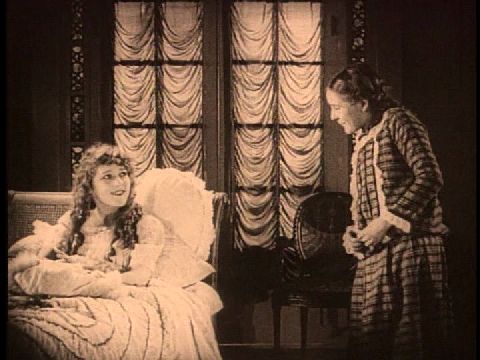Stella Maris (1918) 

Director: Marshall Neilan
Cast: Mary Pickford, Ida Waterman, Herbert Standing
Synopsis: Stella Maris, paralysed since birth, lives in an opulent mansion and has virtually no knowledge of the outside world.
The performance of Mary Pickford is really all that Stella Maris, an otherwise hopelessly outdated melodrama, has to recommend it. Pickford was at the height of her popularity when it was made and plays dual roles here, as the title character and a wretched orphan whose fates are inextricably linked.
Stella Maris (Pickford) is a vibrant young woman confined to her bed by an unspecified illness, and cared for by her Aunt Julia (Ida Waterman) and Sir Oliver Blount (Herbert Standing). To describe these two as over-protective is something of an understatement: for the entirety of Stella’s life she has been essentially cut off from the world, and has no understanding of such concepts as war and poverty. Aunt Julia and Uncle Oliver keep Stella entertained by arranging for cute kiddies to perform maypole dances in her bedroom, or by installing a small menagerie of fluffy bunnies and cuddly kittens. Stella’s only other contact with the outside world is John Risca (Conway Tearle), a distant cousin. John and Stella love one another, but John is married to the alcoholic Louisa (Marcia Manon).
The cruel Louisa adopts Unity Blake (Pickford again), a strange waif-like girl (ironically, Manon was four years older than Pickford) for cheap labour because the hired help never stay long. Following her estrangement from John, Louisa’s mistreatment of Unity comes to a head when she nearly beats her to death over some stolen groceries, a crime for which she is sentenced to three years. John visits Unity in hospital and decides that he will adopt her and take her to live with Aunt Julia. Meanwhile, Stella undergoes one of those miraculous operations so common in silent movies which gets her legs back in working order. Finally mobile, Stella begins to learn some unsavoury truths about the world.
It’s difficult to believe that Stella and Unity are played by the same actress, so completely does Pickford transform herself when playing Unity. It’s not just in the drab clothes and flattened hair, but in the way Pickford seems to shrink in on herself, displaying a crooked smile and tilted head, nervously plucking at her plain clothes. Stella is Pickford in more typical mode, with her luminous smile and voluminous curls backlit to present an angelic image. She’s very good in the split-screen sequences in which she shares time with her screen alter-ego. Too often in these scenes there’s something un-coordinated about the movements of the subjects, but in this movie the two characters really seem to be occupying the same space.
The storyline is typical Victorian fluff – an early 20th-Century chick flick – but that’s not the fault of the movie, simply a symptom of the era. Cinematographer Walter Straddling (who would die of pneumonia before this movie was released), working under Marshall Neilan’s direction, captures some picturesque moments, and makes good use of natural light in the exterior scenes. While the movie belongs to Pickford, she’s aided immeasurably by convincing performances from her supporting cast, particularly Conway Tearle and Marcia Manon. And if you’ve seen The Artist, Michael Hazavanicius’s loving ode to the silent era, the scene in which Unity flirts with John’s jacket hanging from a coat stand might look strangely familiar.
(Reviewed 1st September 2012)
httpv://www.youtube.com/watch?v=TXjWuAZXZ7I
